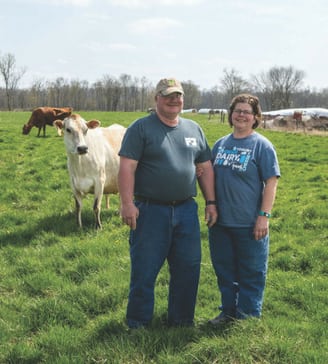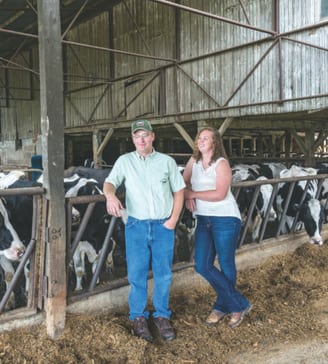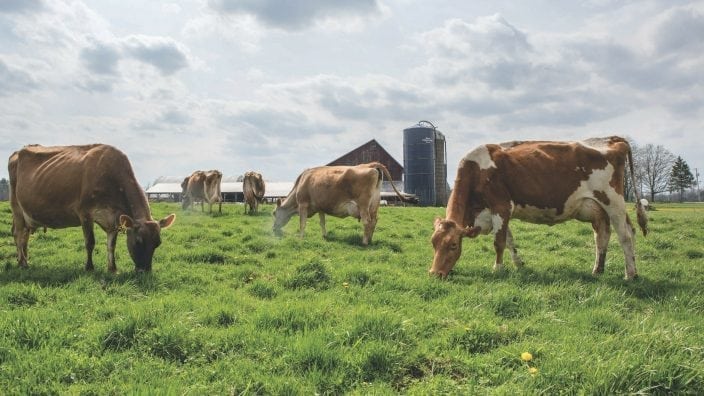Applications for Ohio Farm Bureau Health Plans now available
Members have three ways to apply: contacting a certified agent, calling 833-468-4280 or visiting ohiofarmbureauhealthplans.org.
Read MoreGrim Dairy sounds like a metaphor for the multiyear downturn in milk prices and the struggles of many farms in Ohio and other states.
But Eric Grim, who grazes and milks 70 Jersey and Guernsey cows (and one Ayrshire), in southern Lorain County is more hopeful than his name might suggest. And like many of his dairy peers around Ohio, the Lorain County Farm Bureau member seems to add “philosopher” to the many hats of the modern farmer: mechanic, meteorologist, agronomist, animal husbandry expert and more.
Many view the current dairy-price crisis as a time to examine the role of agriculture in a 21st century economy and evaluate the importance of farms in local communities and the broader society.
“In 2001, I thought there always would be opportunity for small-scale dairy startups,” Grim said. “I never thought the dairy industry would be where it is today.”
Grim is not alone. Dairy farmers of all kinds are feeling the pinch — whether they have 70 cows on pasture or many more in a larger scale operation. Some dairy farm families are seeking organic certification to serve that target market or adding robotic milkers to cut labor costs — all in an effort to find the right strategic approach to profitability.

Others are worse off, having sold their herds to seek a new way to make a living on a family farm.
Average prices this year were $14.43 per 100 pounds of milk (about 11.6 gallons) as of mid-April. That’s down 38 percent from 2014, the last very profitable year for Ohio dairies. And the current cycle of low prices has been unusually long.
“The difference in this down market is the length of it,” said Tuscarawas County Farm Bureau President Jim Rowe of Jimita Holsteins, who milks 200 cows near Strasburg. “Down markets usually last 12 to 18 months and this one is 24 to 28 months, heading into the third year. That’s the issue.”
He said that when markets are strong and milk prices high, farmers should be enjoying their profits. But he worries the next “up market” will instead require farmers to pay off debt from the current squeeze. Then they have no way to get ahead.
That’s what happened to Andy and Danielle Burch, Farm Bureau members in Columbiana County, who sold their entire 120 cow herd in March 2017.
“It didn’t make sense anymore,” Danielle Burch said. “Financially, nothing panned out. Any proper business person would tell you there’s no reason to continue when the books are in the red so consistently you cannot dig out.

“When I married Andy in 2009 — a rough year for corn and dairy prices — I was naive. We added to the herd in 2013 and ‘14. (By last spring) we’d been staring at the truth for about a full year — that if something didn’t change, we would have to sell. We looked at every possible option — adding to the herd, adding robots.”
That’s what the Winner family did in 2013. The switch to a robotic milking system was not cheap, but it pays for itself with reduced labor costs. The three-farm family operation in Logan County is now making the transition to organic production. Renee Winner said the robotic technology and the organic market are particularly important.
“Right now, a small conventional dairy that is not doing something unique would have a hard time,” she said. “We are probably large for the organic market but would be considered small in the conventional.”
Nationally and internationally, demand for dairy products is up, though U.S. milk consumption is down. The number of dairy farms has been declining for decades, but many of the remaining farms are much larger and more efficient.
“Our capacity to produce has outpaced the marketing,” said Scott Higgins, CEO of American Dairy Association Mideast. He said U.S. dairy production has jumped 82 percent since the dairy-checkoff marketing program began in 1984. He sees marketing as the key and notes that national pizza chains are using substantially more cheese, and restaurants like McDonald’s are adding more dairy ingredients to their menus. Also, there’s a push to increase dairy exports from 15 percent of total U.S. production to 20 percent.
“We need to find a way to sell our way out of this,” Higgins said of the current lengthy economic downturn.
Pulling out of the economic downturn might mean selling more milk or, as Grim suggests, asking consumers to take a closer look at agriculture and really think about its role in communities and economies.
What is the ripple effect in a community when a family dairy farm ceases operations? In addition to diminished tax revenue and spending with local businesses, farmland could be lost and the character of a town could change.
How does dairy farming change if the buying power of large food brands has the ability to re-shape the entire industry? Winner sees great value in smaller farms that are on a family scale and engaged in their communities, and she laments the mega corporations contracting with large 1,000 plus cow dairies, in an effort to streamline their dairy processing, are forcing many small dairies to close their barn doors.
Finally, what role does the state or federal government have, if any, to help family dairy farmers?
“Ohio should care what is happening to its dairy farmers,” Burch said. “When you think about state government being close to the people, you’d think there would be a role.”
While the industry is looking for solutions, Grim is already trying to generate public discussion of the place of farms in the economy and society – largely through his role on the advisory board of Lorain County Community College’s Sustainable Agriculture program.
One conversation starter was a recent viewing of “Forgotten Farms,” a 2017 documentary film that focuses on New England dairy farms. The documentary screening event was hosted by Lorain County Farm Bureau and Lorain County Community College to spur a community dialogue. Many recent documentaries have pitted “big ag” against “gig ag,” but this one tries to build bridges. Young farmers want to tap into the expertise of those whose families have been working the same land for 300 years. And the old-timers admire the passion of the newcomers.
“We need to look at things differently. We need to look at sustaining the community, not just buying a jug of milk,” Grim said. “We have to decide as a community how we want dairy to look. What is Lorain County dairy going to look like?”
When dairy farms shut down, the surviving ones aren’t necessarily winners, he said. They lose their support industries – the feed mills and processors that all dairies depend upon. He said local markets bring focus to agriculture.
That’s something the Burches are learning.
“We’re finding a new way,” Danielle Burch said. “We have replacement heifers (future milk cows) from our breeding stock – about 90 heifers.” She’s also partnered with her father on an Angus beef herd and pasture-raised local pork. Both Danielle and Andy have off-farm jobs to diversify their income, which is common for many farm families.
While she sees a growing market for the new ventures, she laments that she doesn’t see the same opportunities in dairy.
Recognizing the plight of dairy farmers in Ohio and around the country, Farm Bureau has been working on solutions.
The American Farm Bureau Federation, in cooperation with American Farm Bureau Insurance Services, has developed a new risk management insurance product for dairy farmers. Approved by the USDA’s Federal Crop Insurance Corporation, Dairy Revenue Protection insurance will provide dairy farmers the opportunity to manage risk by focusing on revenue from milk sales.
“As a dairy farmer I know firsthand the challenges our industry is facing,” said Frank Burkett III, president of Ohio Farm Bureau. “To be part of an organization that thinks outside the box and takes action to create constructive steps to help farmers who are struggling is one of the many reasons I’m proud to be a Farm Bureau member.”
As designed, Dairy Revenue Protection will provide several levels of insurance coverage based on the value of the farmer’s milk. One option will use manufacturing milk futures prices, and the other option would be based on the value of milk components, such as milkfat, protein and other milk solids. A majority of dairy farmers selling milk in the U.S. are paid based on the amount of milkfat and protein in their milk.
It is expected that Dairy Revenue Protection policies will be available in late summer 2018.
Online Extra


Members have three ways to apply: contacting a certified agent, calling 833-468-4280 or visiting ohiofarmbureauhealthplans.org.
Read More

Ryan Hiser has experienced first-hand the importance of having the opportunity to vote on issues that will affect his family operation and other farmers.
Read More

Bill Patterson, Cy Prettyman and Adele Flynn will continue to serve as officers for Ohio Farm Bureau Federation.
Read More

Delegates discussed many topics impacting agriculture including farmland preservation, local foods, and succession planning.
Read More

Twenty-six farmers govern the state’s largest farm and food organization.
Read More

The 2025 recipients are Fred Cooke (posthumous) of Richland County, Marvin Dietsch of Williams County, Steven Knollman of Hamilton County and Michele Miller (posthumous) of Ottawa County.
Read More

Nathan and Jill Parriman grow seasonal crops, including Christmas trees, pumpkins and cut flowers, providing U-cut experiences that invite customers to engage directly with agriculture.
Read More

The 2025 Distinguished Service Award recipients are Craig Adams, Mike Townsley, and Kellogg Farms, Kurt Farms and Stateler Family Farms.
Read More

Ohio Farm Bureau Treasurer Adele Flynn participated in the meeting, representing Ohio farmers.
Read More

For Ohio and PJM region, the outlook is reassuring—ample reserves and strong planning should keep the power on.
Read More